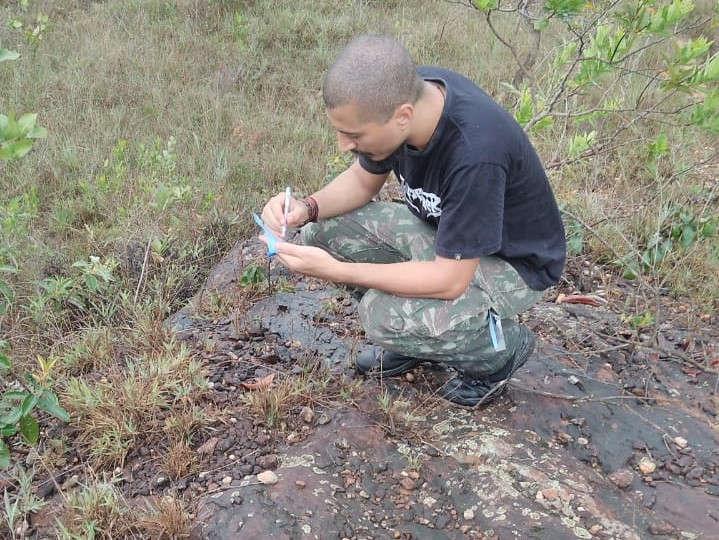Gustavo Henrique de Paula Abrantes
Cyanobacteria are found in several environments, including as biofilms covering rocks in continental habitats. Their importance may go far beyond their role as primary producers, since some species can fix atmospheric nitrogen, an important nutrient. In this project, we will evaluate the contribution of rock biofilms to supply nitrogen to surroundings ecosystems in the Brazilian uplands. We will combine assessments of nitrogen accumulation rates with large-scale quantification of cyanobacteria biomass to prove the ecosystem-wide importance of biofilm nitrogen fixation in the São José Mountain Range (Brazilian state of Minas Gerais), thereby contributing to the conservation of the Brazilian uplands.

Collecting samples in Serra de São José.
São José Mountain Range is an essentially rocky formation located in Brazilian federal state of Minas Gerais. It is formed by sandstone and has a maximum altitude of 1425 meters and an area of approximately 8.475 hectares. It is located in the transition of two conservation hotspots (Cerrado and Mata Atlântica) characterized by high biodiversity and endemism. The rocky portion of this mountain range is covered by Campo Rupestre, a very particular highland subtype of the Cerrado biome. São José is part of the Espinhaço Range, which was considered by UNESCO in 2005 as a Biosphere Reserve, and that is under strong anthropogenic pressure.
With this project, we expect to make more evident the importance of the Brazilian upland mountain ranges by providing a large scale ecosystem service as an argument to the protection of these areas. The present project will generate information to show their role as an important source of nitrogen to adjacent systems, such as rivers, forests and savannahs, which is probably fundamental for the functioning of these environments. Nitrogen is fundamental for vegetation establishment and development, and we hypothesize that the maintenance of the surrounding systems is partially determined by its fixation and exportation from São José Mountain Range. We predict a strong correlation between the cyanobacteria densities on rocks and the quantity of nitrogen exported, measured as N input in water passing through rock surfaces. Therefore, we can elucidate the relationship between the terrestrial cyanobacteria located on the mountains and their contribution for the functioning of this and other ecosystems.
The results will describe a process that certainly occurs in other mountain ranges of the Espinhaço Range complex, not only in the São José Mountains. Among the more important aspects, we can cite the fertilization effect of fixed and exported nitrogen to agricultural areas adjacent top the studied mountais, and the nitrogen supply to the adjacent pristine ecosystems. We also expect more involvement of the communities in the management for the mountain conservation, once demonstrated its fertilization effect to agriculture in adjacent lands. From a long-term perspective, since the mountains of Minas Gerais state suffer high pressure to mountaintop mining, increased efforts to their conservation should result in the conservation of many associated species. Many of these organisms are threatened because they are endemic or with rare distribution in this specific biome (Cerrado), which shows a very particular soil and vegetation formation, the Campo Rupestre.